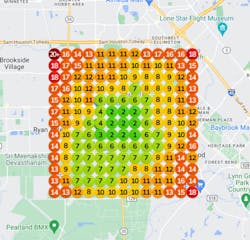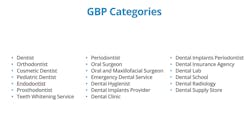Consider your habits when you search for a local business. How often do you find what you're looking for on Google Maps? How often do you use the Google Maps app on your phone to find a local business? Ranking well on Google Maps is the most effective online marketing method for a dentist to be found by local patients. Cutting-edge dental marketing companies are focused on helping their clients optimize for Google Maps.
Dental practices hoping to attract new patients for high-value cases such as dental implants, sleep devices, cosmetic surgeries, and smile makeovers should be aware of their current ranking on Google Maps for those search phrases. Once you understand how you rank, you can implement a strategy for improvement.
More marketing info from Adrian Lefler
How to get more dental implant patients with Google Maps
Dentists now allowed to use Google Local Service Ads
What is a Google Business Profile (GBP)?
A common misunderstanding is that the information about your practice on Google Maps comes from your website. It actually comes from your Google Business Profile, which is your business listing in the Google Business database. Most small business owners are not aware that they can perform dental SEO to optimize their GBP, enabling it to rank higher on Google Maps. Rankings depend on three optimization aspects: prominence, distance, and relevance.
What is prominence in Google Maps optimization?
Prominence relates to how recognized you are in your community. Prominence is the most challenging of the three optimization aspects because Google measures prominence through inbound links. Getting an inbound link is a challenge in and of itself. An example of a great inbound link is for a colleague in your town to write an article about your practice and post that article to their website. Links to your website from the post act like votes of confidence. More votes equal higher rankings.
What is distance in Google Maps optimization?
Google Maps is a location-based result. The location of your practice and the location from where the person is searching influences the search results. Your practice may be ranking on the front page of Google a mile north of your practice, but it may not be ranking a mile south of your practice.
Location-based results are complicated, and the best way to understand them is to run a Google Maps grid report, which shows how high you're ranking on Google Maps when people search from areas around your location. Figure 1 is an example of a Google Maps grid report. The number on the colored dots is where the practice ranks when someone searches from that location. If the colored dot has a 1, 2, or 3, then the practice will be on the first page of Google Maps.
You can find a more in-depth video explanation of how Google Maps results work here.
What is the relevance of Google Maps optimization?
Relevance is a correlation between the patient's search phrase and the information in your GBP. For instance, a potential patient searches for the "best dental implant dentist." You provide dental implants, but your GBP categories do not list you as a dental implant provider, which creates a problem in ranking for dental implant phrases. The good news is that it's a simple process to update your categories.
How to optimize for dental implants and other high-value services
Determine your ranking: First, figure out how well you're ranking. If you send a request using this form, we'll run the grid reports for your chosen keywords. I recommend that you have us run them for “dental implants,” “cosmetic dentist,” “smile makeovers,” and any other keywords you're interested in.
Locate your GBP profile: Here’s a video explaining how to find your GBP profile.
Update your primary and secondary category: You can have one primary category and multiple additional categories. My recommendation is to have no more than three in total. Categories are set by Google. You must choose from their list of dental categories. Figure 2 shows all the categories.
If you’re a general dentist, your primary category should be "dentist," not "dental clinic." If you're an orthodontist, periodontist, prosthodontist, pediatric dentist, etc., make your primary category the same as your specialty. The only situation I've come across where you might want to break this rule is if you're a general dentist but you want only cosmetic patients. In that case, you could make your primary category "cosmetic dentist" and your secondary category "dentist." By doing so, you'll rank better for cosmetic terms and less for dental terms.
The caveat is that "dentist" gets 10 times more search volume than “cosmetic dentist,” and many people searching for a cosmetic procedure may be using cosmetic search phrases. How many times do you think someone looking for veneers searches for "best dentist near me?"
Go the extra mile with your optimization: For those who want to take optimization further, watch this dental SEO training video that covers the top 10 steps for Google Maps optimization.
Optimizing Google Maps should be a primary task for any dental marketing manager. It's not difficult, but it does take time. If done correctly and you start to rank at the top of the search, the increase in new-patient calls can be significant. Take advantage of some of the free resources we've created to help you get started optimizing and attracting new high-value patients.
About the Author
Adrian Lefler
Adrian is a dental marketing expert and the vice president of My Social Practice, a digital dental marketing agency. Lefler regularly travels to speak and educate dentists about dental marketing topics. You can book him to speak on this page. He lives in Draper, Utah, with his professional chef spouse, four kids, and two dogs.


